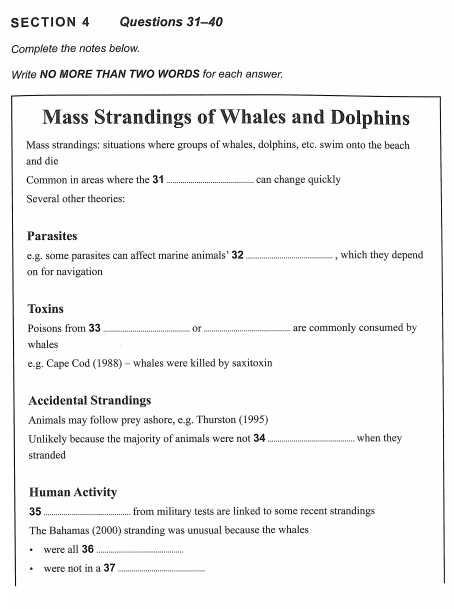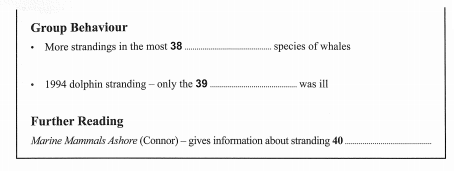剑桥雅思9听力:Test2雅思听力Section4解析
发布时间:2021-05-11 关键词:剑桥雅思9听力Section4
Good morning.
Today I'd like to present the findings of our Year 2 project on wildlife found in gardens throughout our city.
I'll start by saying something about the background to the project, then talk a little bit about our research techniques, and then indicatesome of our interim findings.
First of all, how did we choose our topic?
Well, there are four of us in the group and one day while we were discussing a possible focus, two of the group mentioned that they had seen yet more sparrow hawks - one of Britain's most interesting birds of prey - in their own city centre gardens and wondered why they were turning up in these gardens in great numbers.
We were all very engaged by the idea of why wild animate would choose to inhabit a city garden.
Why is it so popular with wildlife when the countryside itself is becoming less so?
The first thing we did was to establish what proportion of the urban land is taken up by private gardens.
We estimated that it was about one fifth, and this was endorsed by looking at large-scale usage, maps in the town land survey office - 24% to be precise.
Our own informal discussions with neighbours and friends led us to believe that many garden owners had interesting experiences to relate regarding wild animal sightings so we decided to survey garden owners from different areas of the city.
Just over 100 of them completed a survey once every two weeks for twelve months - ticking of species they had seen from a pro forma list - and adding the names of any rarer ones.
Meanwhile, we were doing our own observations in selected gardens throughout the city.
We deliberately chose smaller ones because they were by far the most typical in the city.
The whole point of the project was to look at the norm not the exception.
Alongside this primary research on urban gardens, we were studying a lot of books about the decline of wild animals in the countryside and thinking of possible causes for this.
So what did we find?
Well, so much that I just won't have time to tell you about here.
If you're interested in reading our more comprehensive findings, we've produced detailed graphic representations on the college web-site and of course any of the group would be happy to talk to you about them.
Just email us.
What we've decided to present today is information about just three species - because we felt these gave a good indication of the processes at work in rural and urban settings as a whole.
The first species to generate a lot pf interesting information was frogs.
And there was a clear pattern here - they proliferate where there is suitable water.
Garden ponds are on the increase, rural ponds are disappearing, leading to massive migration to the towns.
Hedgehogs are also finding it easier to live in urban areas - this time because their predators are not finding it quite so attractive to leave their rural environment , so hedgehogs have a belter survival rate in cities.
We had lots of sightings, so all in all we had no difficulties with our efforts to count their numbers precisely.
Our final species is the finest of bird singers, the song thrush.
On the decline in the countryside, they are experiencing a resurgence in urban gardens because these days, gardeners are buying lots of different plants which means there's an extensiverange of seeds around, which is what they feed on.
Another factor is the provision of nesting places — which is actually better in gardens than the countryside.
Hard to believe it, but it's true.
Incidentally, we discovered that a massive new survey on song thrushes is about to be launched, so you should keep an eye open for that.
Now, I’d be happy to answer any questions you may have…


Question 31
答案:C
定位原文:scripts: First of all, how did we choose our topic? Well, there are four of us in the group and one day while we were discussing a possible focus, two of the group mentioned that they had seen yet more sparrow-hawks, one of Britain's most interesting birds of prey, in their own city centre gardens and wondered why they were turning up in these gardens in great numbers. We were all very engaged by the idea of why wild animals would choose to inhabit a city garden. Why is it so popular with wildlife when the countryside itself is becoming less so?
解题思路:本题对应原文中谈及近来出现的有趣现象:野生动物回迁城市。本题需要对原文内容有综合理解才能得出答案 C。选项 A 并未涉及,选项 B 可能由于 city growth 一词造成混淆,但增长的不是城市,而是城市中食雀鹰的数量。
Question 32
答案:A
定位原文:scripts: The first thing we did was to establish what proportion of the urban land is taken up by private gardens. We estimated that it was about one fifth, and this was endorsed by looking at large-scale usage maps in the town land survey office, 24% to be precise.
解题思路:题干词 proportion 原文重现,方便定位。large-scale 在选项中可能造成混淆,但 photo 一词并未出现。land survey office 为官方机构,因此文件是官方认可的。
Question 33
答案:B
定位原文:scripts: Our own informal discussions with neighbours and friends led us to believe that many garden owners had interesting experiences to relate regarding wild animal sightings, so we decided to survey garden owners from different areas of the city. Just over 100 of them completed a survey once every two weeks for twelve months, ticking off species they had seen from a pro forma list and adding the names of any rarer ones.
解题思路:本题题干 garden owners 原文重现,帮助定位。选项中的 keep a record 与原文 ticking 同义替换。
Question 34
答案:B
定位原文:scripts: We deliberately chose smaller ones because they were by far the most typical in the city. The whole point of the project was to look at the norm not the exception.
解题思路:本题与上一题距离较近,需要反应。题干词 observation 原文重现,选项 representative 与原文 typical 为同义替换。
Question 35
答案:A
定位原文:scripts: Alongside this primary research on urban gardens, we were studying a lot of books about the decline of wild animals in the countryside and thinking of possible causes for this.
解题思路:本题题干中的 reading 应当与原文中的 books 迅速对应,rural area 意为乡村地区,与原文 countryside 可以 对应。urban 在原文涉及 books 一句中未提及。考生需要理解 gardening practice 的意思为“园艺操作”,从而判断与选项 C 无关。
Question 36
答案:C
定位原文:scripts: What we've decided to present today is information about just three species because we felt these gave a good indication of the processes at work in rural and urban settings as a whole.
解题思路:本题答案为概括性内容,考生需要理解原文含义才能找出适合选项。题干词 three animal species 可以帮助定位,之后主讲人解释原因:good indication...as a whole 指对整体情况是一个好的解释。
Question 37
答案:frog/frogs
定位原文:scripts: The first species to generate a lot of interesting information was frogs.
解题思路:本题在表格第 一列,对应纵轴已知信息及标题 animal 可以得知需要填写某一种动物,原文较直接给出 frogs, 无混淆信息。
Question 38
答案:predators
定位原文:scripts: Hedgehogs are also finding it easier to live in urban areas- this time because their predators are not finding it quite so attractive to leave their rural environment, so hedgehogs have a better survival rate in cities.
解题思路:本题通过读题可以判断需要名词,题干意为“在城市内从……那里比较安全”。但答案在句首,可能漏听;记忆能力不够强可能导致忘记,且词汇较难。
Question 39
答案:count
定位原文:scripts: We had lots of sightings, so all in all we had no difficulties with our efforts to count their numbers precisely.
解题思路:本题通过读题判断需要动词。涉及答案的句子仅出现动词 count。
Question 40
答案:seed/seeds
定位原文:scripts: On the decline in the countryside, they are experiencing a resurgence in urban gardens because these days gardeners are buying lots of different plants which means there's an extensive range of seeds around, which is what they feed on.
解题思路:本题通过读题判断需要名词。题干 a variety of 与原文 an extensive range。题义替换,后紧跟答案 seeds。




